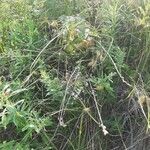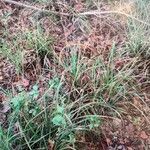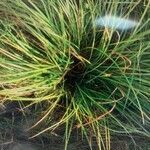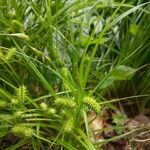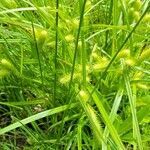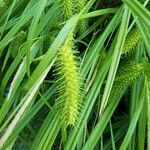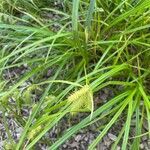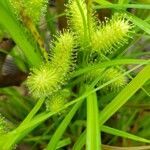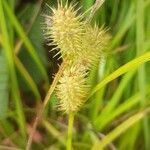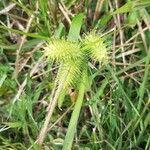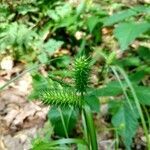Tufted, without long rhizomes; stems aphyllopodic, 2–10 dm, usually surpassed by the lvs, obtusely trigonous and smooth or nearly so, purplish at base; lvs septatenodulose, with flat blade (2–) 4–7 mm wide; ligule triangular, distinctly longer than wide; terminal spike staminate, 1–7 cm, its scales with the midrib prolonged into an evident awn; pistillate spikes 1–4, approximate, or the lower remote, sessile and erect or (especially the lower) evidently pedunculate and even drooping, 1–7.5 × 1.4–2 cm, densely fld; bracts leafy, surpassing the infl, with or without a sheathing base; pistillate scales rough-awned, or the upper merely acuminate; perigynia numerous, in many rows, 6–9 mm, ovoid or ovoid-globose, somewhat inflated, pale, smooth and shining, strongly ca 10-nerved, with a slender, bidentate beak half to almost as long as the body; achene concavely trigonous, densely granular, loosely enveloped in the lower part of the perigynium, the persistent style twisted or abruptly bent. Swamps and wet meadows and woods; N.S. to Minn., s. to Fla. and Mex.
Dense clumps up to 90 cm tall. Stems stout, erect, 3-angled, smooth or slightly scabrid on angles below inflorescence. Leaves 5-8 mm wide, ± = stems, flat, many small internal septa noticeable when dry; sheaths red to almost black. Inflorescence of large approximate spikes each with long leaf-like bract. Male spike 1, 5-6 cm × 2 mm, peduncle short; glumes narrow with long scabrid awns. Female spikes usually 3, upper sessile, rest shortly pedunculate, 2-4 × ± 1.5 cm, glumes much < utricles except at base of spike, narrow, hyaline, with an extremely long awn. Utricles 6-9 × 2-4 mm, strongly inflated, distinctly nerved, shining, smooth, greenish-brown, beak very narrow, bifid, c. ½ length of utricle. Stigmas 3. Nut trigonous, obovate, style strongly curved above base.
